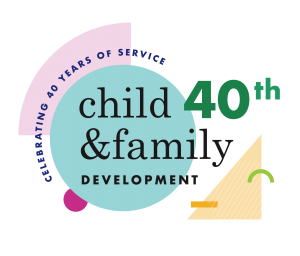By Jessica Turchin, MPT, ATRIC, Child & Family Development
I have been a pediatric physical therapist for 15 years and work with children of all ages and abilities. I especially love my time working with some of our littlest clients — babies! One of the most common musculoskeletal condition that many babies experience is torticollis. Torticollis is a Latin word meaning “twisted neck.” It is generally characterized by a preference for a certain position of the neck. Many of the families that come to see me with this diagnosis have heard of the condition but are not as clear on the cause of the condition or the variety of treatment techniques that therapy can do to help.
Babies with torticollis usually prefer to rotate their head to one side but laterally flex or tilt their neck to the opposite side. This position is caused by a shortening or tightness of the sternocleidomastoid muscle (SCM) on one side of the neck. For instance, if the left SCM muscle is tight, the baby would tend to keep their head rotated to face to the right but tilt their left ear towards their left shoulder. Consequently, the right SCM could become weakened due to lack of use to turn the head to the left and tilt the right ear towards the right shoulder. Tightening of this muscle is usually caused by position in utero during the last few weeks of gestation but can also be caused by positioning after birth as well. During our evaluation, we also make sure to look at the entire spine and body. Asymmetries in a baby’s pelvis and hips can lead to asymmetries in the neck as well. One analogy we use is that if a flower is growing out of the ground crooked, the beginnings of misalignment can be down at the roots in addition to the top of the stem. Neck misalignment can also present as a preference for same side rotation and lateral flexion but this presentation is less common.
Torticollis is usually evident by 3-4 months old as the baby is developing head control, but it can be observed earlier. Other early symptoms that parents or caregivers might observe could be preference for nursing on one side, preference for being held on one side while drinking from a bottle, difficulty fully cleaning one side of the neck, or difficulty dressing the baby with moving one arm versus the other.
Traditional treatments for torticollis involve stretching one side of the neck and strengthening the other. We have a variety of positioning options on the floor, in swings and bouncy seats, and while being held that we can teach caregivers that encourage a baby to stretch their muscles in a gentle way that is easy to tolerate. We also teach massage for tight muscles and strengthening activities in a variety of developmental positions with visual and auditory interest on the non-preferred side to encourage symmetry of muscle force and posture as well as encourage the timely occurrence of developmental milestones.
Other effective treatments include more specialty hands-on approaches such as myofascial release techniques, including Total Motion Release™ to address motion restrictions in tissues surrounding muscles called fascia. Fascia is another layer of tissue under the skin that holds the muscles, nerves, and blood vessels securely in place. Fascia can have areas of tightness, called adhesions, just like muscles that can cause decreased flexibility and impaired posture. Myofascial release is a very gentle hands-on technique that most babies enjoy and experience greater movement after almost immediately.
Another technique that can be beneficial for babies with torticollis, and especially babies that also experience plagiocephaly, or flattening of part of the head from pressure on the bones from being in one position too long, is Craniosacral Therapy™. Craniosacral Therapy™ is a very gentle, hands-on technique that works with the flow of cerebrospinal fluid in the head and down the spine, as well as the rhythm of movement throughout the body. This treatment technique is focused on releasing restrictions and adhesions to improve range of motion, decreasing strain on the nervous system due to physical discomfort and asymmetrical muscle pulls, and influencing reshaping of the cranial bones using the body’s own natural movements to either prevent the need for cranial band (helmet) intervention or decrease the amount of time a band would need to be worn.
On a rare occasion, older children can demonstrate residual effects of torticollis if the condition was either not observed when they were young or they experienced regression when they started to grow faster in height. Older children usually demonstrate more of a preference for a head tilt than rotation. Older children can benefit from a lot of these same techniques to improve their range of motion, strength, and posture to help them maximize their abilities in all other aspects of their lives.
Jessica Turchin is a Physical Therapist at Child & Family Development. Our offices provide services to children, teens and young adults with developmental, neurological and congenital impairments. Services can be habilitative (learning a skill for the first time) or rehabilitative (becoming more proficient at a skill or relearning a skill). We focus on improving and adapting a child’s gross motor abilities. Contact us to schedule an appointment today. We are open and here to help.
Child & Family Development

Website
Facebook
Instagram
Twitter
Locations:
Mitdtown:
4012 Park Road, Suite 200
Charlotte, NC 28209
704.332.4834
Pineville:
10516 Park Road
Charlotte, NC 28210
704.541.9080



